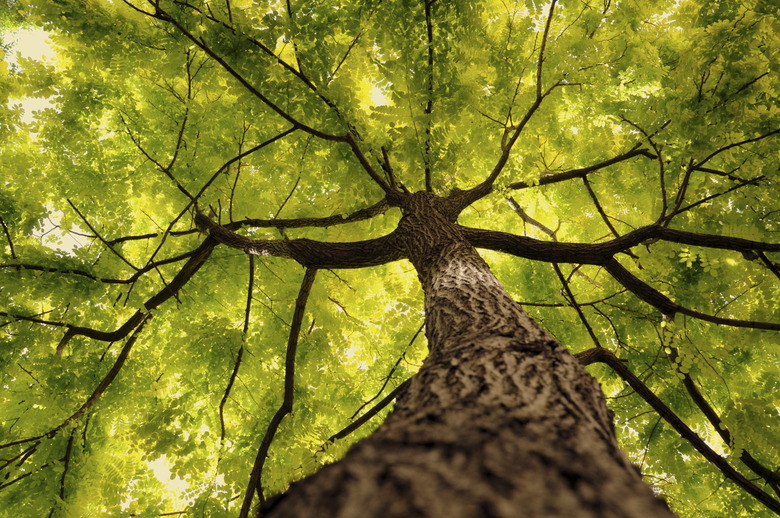Tree Caliper Vs. Canopy Size
Both a tree's trunk diameter, which for young trees is often expressed with a measurement called caliper, and its canopy spread provide clues to the tree's age and health. Taken together, the two measurements present an even more complete, precise indication of the tree's overall structure.
Both a tree's trunk diameter, which for young trees is often expressed with a measurement called caliper, and its canopy spread provide clues to the tree's age and health. Taken together, the two measurements present an even more complete, precise indication of the tree's overall structure.
Tree Caliper Measurement
Tree caliper is a measurement of a tree's trunk diameter taken close to the ground. Standards published by the American Nursery & Landscape Association specify that caliper should be measured at a height of 6 inches above the soil level for trees whose trunk diameter is 4 inches or less; if the trunk diameter is larger, caliper should be measured at 12 inches above the ground. Because the caliper measurement is only useful in comparing the sizes of young trees, it is generally used in describing nursery stock and not mature trees. Tree caliper as a measurement shouldn't be confused with the tool commonly used to measure the diameter of a tree's trunk, which is also sometimes called a tree caliper.
Caliper vs. DBH
The trunks of mature trees usually swell in diameter near the ground, making trunk diameter near the soil level an inaccurate representation of the tree's overall size. Therefore, the generally accepted method for measuring a mature tree's trunk is to measure the trunk diameter at a point 4.5 feet above the ground; this measurement is called "diameter at breast height" or DBH.
- Both a tree's trunk diameter, which for young trees is often expressed with a measurement called caliper, and its canopy spread provide clues to the tree's age and health.
- The trunks of mature trees usually swell in diameter near the ground, making trunk diameter near the soil level an inaccurate representation of the tree's overall size.
Tree Canopy Measurement
The proportion of a tree's trunk diameter to the spread of its canopy varies from species to species. Measuring the average spread of a tree's canopy as well as its trunk diameter provides a more complete picture of a given tree's overall size. To measure the average spread of the canopy, begin by measuring the widest distance between the ends of the tree's branches as they extend from the trunk. An easy way to do this is to find the branch that extends farthest from the trunk and put a stake in the ground under the end of the branch, then follow an imaginary line from the stake through the trunk to the end of the branches on the opposite side of the tree. Drive another stake at that point, and measure the distance between the two stakes. Do the same thing at the narrowest part of the tree's canopy. Adding the two measurements together and dividing by 2 gives you the tree's average canopy spread.
- The proportion of a tree's trunk diameter to the spread of its canopy varies from species to species.
- To measure the average spread of the canopy, begin by measuring the widest distance between the ends of the tree's branches as they extend from the trunk.
Relationship Between Trunk Diameter and Canopy Spread
Understanding the relationship between a tree's canopy spread and its trunk diameter can be useful to forestry professionals because it can allow them to estimate a tree's trunk diameter by measuring its canopy size via remotely taken images. The relationship between the two measurements and other characteristics of a tree can also be useful to the home gardener; it's helpful to know when estimating a tree's root spread, for example, that the root system diameter is typically more closely related to trunk diameter than to canopy spread.
